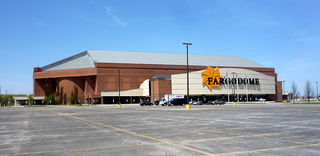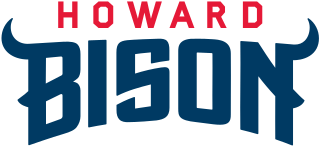
Robert F. Kennedy Memorial Stadium, commonly known as RFK Stadium and originally known as District of Columbia Stadium, is a defunct multi-purpose stadium in Washington, D.C. It is located about two miles (3 km) due east of the U.S. Capitol building, near the west bank of the Anacostia River and next to the D.C. Armory. Opened in 1961, it was owned by the federal government until 1986.

Fargodome is an indoor athletic stadium in the north central United States, located on the campus of North Dakota State University (NDSU) in Fargo, North Dakota. Opened 31 years ago in late 1992, the facility is owned by the City of Fargo and built on university land. Not an actual dome, its seating capacity is 18,700 for football and over 25,000 for full arena concerts. Its approximate elevation at street level is 900 feet (275 m) above sea level.
Throughout the years, a number of teams in the National Football League (NFL) have either moved or merged.

Kingman Park is a residential neighborhood in the Northeast quadrant of Washington, D.C., the United States capital city. Kingman Park's boundaries are 15th Street NE to the west; C Street SE to the south; Benning Road to the north; and Anacostia Park to the east. The neighborhood is composed primarily of two-story brick rowhouses. Kingman Park is named after Brigadier General Dan Christie Kingman, the former head of the United States Army Corps of Engineers.
The 1984 Washington Redskins season was the franchise's 53rd season in the National Football League. They failed to improve on their 14–2 record from 1983 and finished at 11-5. Art Monk set an NFL record for most receptions in a season. The Redskins started the season losing their first two games but would recover to win their next five games. A mid-season slump had them on the playoff bubble at 7-5. However, the Redskins would finish the season in strong fashion winning their final four games to win the NFC East with an 11-5 record. The Redskins quest for a third straight NFC Championship ended quickly as the Skins were stunned by the Chicago Bears 23-19 at RFK Stadium, Washington's only playoff loss at RFK. The 1984 Redskins have an NFL-record 14 straight games with 3 or more sacks, having accomplished that from weeks 3 to 16.
The 1974 Washington Redskins season was the franchise's 43rd season in the National Football League (NFL) and their 38th in Washington, D.C. The team matched on their 10–4 record from 1973. It is also notable for being Deacon Jones' first and only season with the Redskins; as well as being his final year in the NFL.
The 1973 Washington Redskins season was the franchise's 42nd season in the National Football League (NFL) and their 37th in Washington, D.C. The team failed to improve on their 11–3 record from 1972, and finished 10-4.

The 1972 Washington Redskins season was the 41st in the National Football League (NFL) and the 36th in Washington, D.C. The Redskins were trying to build on the success of the previous season, in which they had finished 9–4–1 and made the postseason for the first time in 26 seasons. They ultimately finished the year 11–3.

The 1971 Washington Redskins season was the team's 40th in the National Football League, and its 35th in Washington, D.C. The Redskins were led by first-year head coach George Allen, who had been the head coach of the Los Angeles Rams for the previous five seasons.

The Howard Bison and Lady Bison are the intercollegiate athletic teams that represent Howard University, located in Washington, D.C. The Bison compete in Division I of the National Collegiate Athletic Association (NCAA)'s and Division I Football Championship Subdivision (FCS) and are members of the Mid-Eastern Athletic Conference for most sports. On July 16, 2015, the Athletics Department unveiled new logos, replacing the previous logo that was nearly identical to that used by the National Football League's Buffalo Bills.

The Howard Bison football team represents Howard University in college football at the NCAA Division I Football Championship Subdivision (FCS) level as a member of the Mid-Eastern Athletic Conference (MEAC).
A total of twenty-nine sports venues were used for the 1996 Summer Olympics.

The 2015 Howard Bison football team represented Howard University in the 2015 NCAA Division I FCS football season. They were led by fourth year head coach Gary Harrell. The Bison played their home games at William H. Greene Stadium. They were a member of the Mid-Eastern Athletic Conference. They finished the season 1–10, 1–7 in MEAC play to finish in a four way tie for eighth place.

The Real HU is an American college football rivalry game played annually by the Bison of Howard University and the Pirates of Hampton University. The series started in 1908 and is driven by several factors, which include the close proximity of the two Mid-Atlantic schools, the historically high academic standing of both these private institutions as Howard and Hampton are considered Black Ivy League universities and have student-alumni populations from similar backgrounds, and that the two schools have competed in the same athletic conferences for approximately a century.

The 2018 Howard Bison football team represented Howard University in the 2018 NCAA Division I FCS football season. They were led by second-year head coach Mike London. The Bison played their home games at William H. Greene Stadium. They were a member of the Mid-Eastern Athletic Conference (MEAC). They finished the season 4–6, 4–3 in MEAC play to finish in a tie for fourth place.

The 2019 Howard Bison football team represented Howard University as a member Mid-Eastern Athletic Conference (MEAC) during the 2019 NCAA Division I FCS football season. The Bison were led by first-year head coach Ron Prince until he was placed on administrative leave prior to the team's November 9 game, with director of football operations Aaron Kelton named as interim head coach. Howard finished the season with an overall record of 2–10 and mark of 2–6 in conference play, tying for seventh place in the MEAC. The Bison played home games at William H. Greene Stadium.

The 2020 Howard Bison football team represented Howard University in the 2020–21 NCAA Division I FCS football season. The Bison played their home games at William H. Greene Stadium. They were a member of the Mid-Eastern Athletic Conference (MEAC). The Bison were led by first-year head coach Larry Scott.
Kehoe Field is the name of two fields that served as the home of the Georgetown Hoyas intramural sports and varsity athletics teams, including several seasons of Hoyas football, since the 1950s. They occupied the same site, successively, on the Georgetown University campus in Washington, D.C.

The 2022 Howard Bison football team represented Howard University as a member of the Mid-Eastern Athletic Conference (MEAC) in the 2022 NCAA Division I FCS football season. The Bison, led by third-year head coach Larry Scott, played their home games at William H. Greene Stadium.

The 2023 Howard Bison football team will represent Howard University as a member of the Mid-Eastern Athletic Conference (MEAC) in the 2023 NCAA Division I FCS football season. The Bison, led by fourth-year head coach Larry Scott, play home games at William H. Greene Stadium in Washington, D.C.












